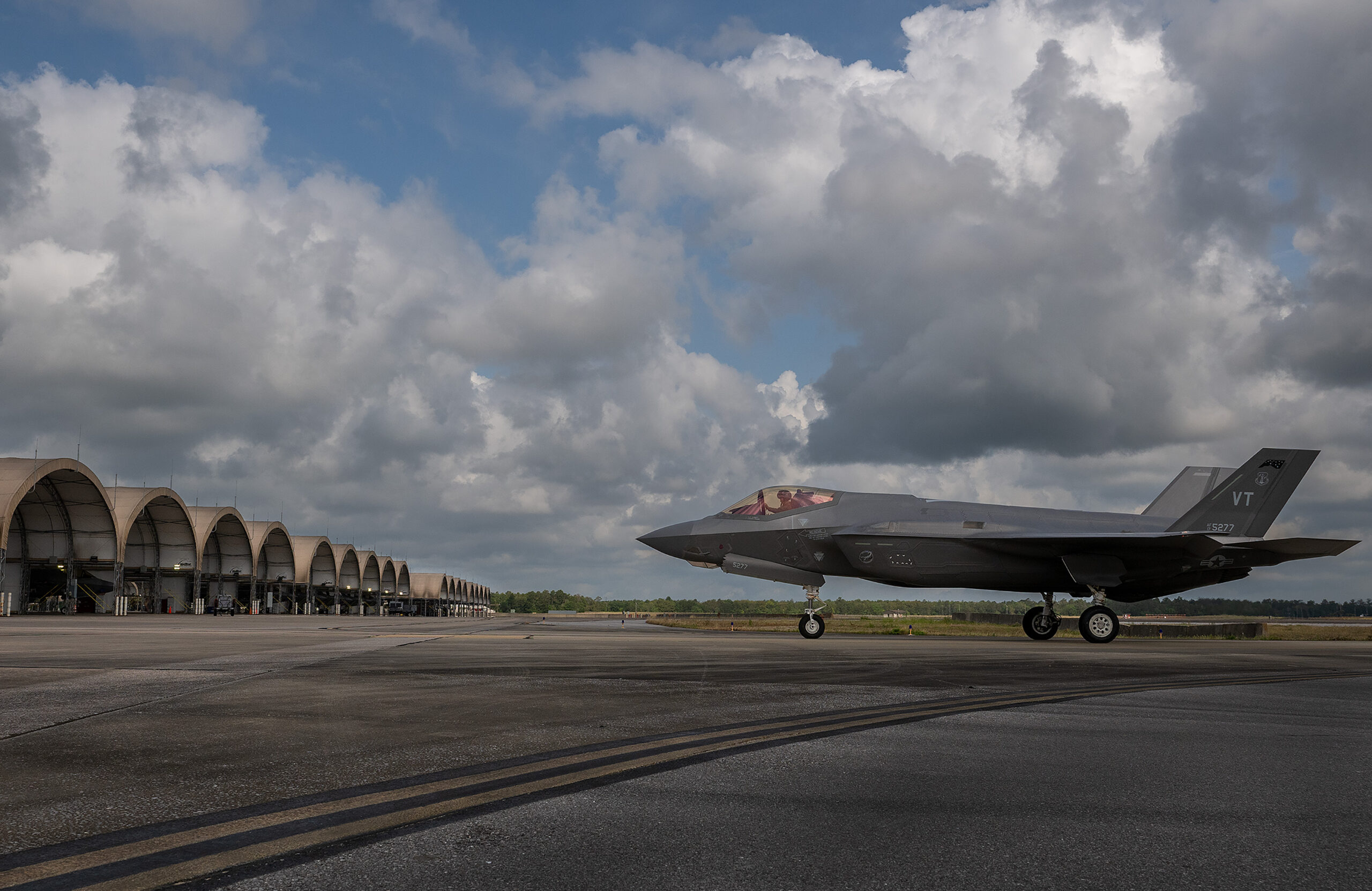The Pentagon’s Director of Operational Test and Evaluation has sent fresh shockwaves through the F-35 community. His memo to senior leaders says the Joint Strike Fighter remains far from its promised combat edge even though the U.S. Air Force just marked the jet “ready for war.” Engineers still chase hundreds of software defects, the 25 mm gun refuses to shoot straight, and the off-boresight missile link misbehaves whenever pilots swivel their helmets too far off center. The memo also warns the program could run out of development money before solutions mature, forcing painful trade-offs or schedule slips at the worst possible moment.
Joint Program Office chief Lt. Gen. Christopher Bogdan pushes back. He argues every flaw already sits on a fix list, progress tracks each line, and the calendar still holds. Yet the numbers cut another story. Test teams need roughly three hundred more instrumented flight hours to wrap Block 3F. Each new discovery adds sorties. Each sortie burns money the program banked years ago under different assumptions. If discoveries keep piling up, budgets snap.
Persistent F-35 Problems Plague Block 3F Development
During May shots the small door that hinges open on the left side kicked the nose a hair to starboard, spoiling aim by several mills at fifty meters. Test pilots tried trim tweaks. Software engineers tried filter tricks. Nothing stuck. The door simply breaks the airflow. If coders cannot tame the slide with a fresh control-law patch, mechanics will need physical shims—an ugly job that risks yet another delay to accuracy trials that must begin before the gun can join real troops in 2018.
Pods for the Marine Corps B-model and Navy C-model lag further behind. Ground runs shook fairings until fasteners backed out. Electrical noise bled into the weapons bus. Designers reordered brackets; suppliers chased a higher vibration spec. Those pods were supposed to feed carrier work-ups in 2018. The calendar grows thin.
F-35 Gun Accuracy Issues Undermine Combat Readiness
Labs churn code under agile slogans, yet the backlog of “Category-1” faults keeps swelling. Weapons separation tests in early summer flushed out new timing errors in sensor fusion, fresh glitches in radio hand-offs, and a baffling freeze when pilots cycled the Distributed Aperture System overlays too fast. Every fix lands as another load to test, and every load spawns fresh issues. The loop feels endless.
Here is a snapshot of trouble spots the memo highlights:
- 25 mm gun door induces yaw that ruins short-bursts accuracy
- AIM-9X cues fail beyond twenty degrees off boresight
- Mission-systems code lists 400-plus priority defects waiting for repair
- Autonomic Logistics Information System loses part histories whenever aircraft hop between poorly wired bases
DOT&E Report Reveals F-35 Software and Sustainment Failures
The database is supposed to follow each serialized spare through life, yet fiber links at some forward operating sites drop packets. When that happens, the jet cannot download health data; crew chiefs re-enter numbers by hand; and commanders lose real-time readiness views. Paper forms slow the line. Parts orders lag. The next sortie slips.
Concurrency adds another drag. More than 150 operational airframes already need design changes pulled from later test findings. Depots juggle retrofit lines against scheduled overhauls, so bays clog and downtime surges. Operational commanders watch fleet availability fall below sixty percent, still far off the eighty percent goal baked into future war plans. Mean time between critical failure sits near ten hours—half the target.
Maintenance and ALIS Failures Impact F-35 Fleet Availability
Sustainment projections still bank on optimistic spares usage and brisk learning at repair cells. Yet vendors report thin surge capacity, and the queue of power modules at Pratt & Whitney’s repair line stretches past ninety days. Each delay propagates. Jets wait on engines, parts bins dry out, and wing commanders shuffle sorties to cover gaps.
Money and time thus collide. The program needs extra cash or extra months—or both. DOT&E says the final exam, Initial Operational Test and Evaluation, cannot start until fixes clear. Bogdan insists the team will close every open item inside the current funding wedge; critics counter the budget guardrails crack under the weight of surprises still hiding in flight tests.
Operational demonstrations fuel both camps. When the Air Force flew scripted trials at Mountain Home, pilots bagged sixteen kills for every friendly loss against legacy threats. Advocates cheered. Skeptics noted the scenario favored stealth entrants and downplayed wide-area air defenses still under development abroad. Real combat, they argue, strains seams the memo exposes.
Flight Testing Delays and Budget Strains Threaten Full-Rate Production
The last big hurdle now sits in the Joint Simulation Environment, a digital war space that models dense, modern missiles and radar nets. Government coders have not yet validated threat files or finished the interface boards that let a live F-35 “fly” inside that world. Until JSE locks in, the full-rate production decision stays parked. Industry hates the pause because production lots, priced years in advance, rely on stable flows. Hill staff worry, too; every month of indecision invites another budget renegotiation.
Program insiders whisper a blunt truth: even if development wraps, sustainment threatens to eat every dollar saved elsewhere. Racks of line-replaceable modules await new cooling ducts. Canopies flake their stealth coating sooner than planned. And the nitrogen On-Board Inert Gas Generation System still throws false alarms in hot climates, grounding jets for inspections that rarely find leaks.
Yet fighters keep rolling off the Fort Worth line. Foreign customers from Norway to South Korea accept deliveries, then send back spare parts lists longer than expected. Each nation tunes training to local weather, base layouts, and budget quirks. The common configuration cracks under such diversity, spawning fresh variants of depot tooling and technical orders.
Inside the Pentagon, auditors ask why mission-capable trends stagnate. The answer blends complex software, fragile supply chains, and funding cycles that shut lines for weeks. When fiscal calendars dictate stop-work gaps, skilled technicians drift away, forcing contractors to hire and retrain. Productivity drops. Costs rise. The cycle repeats.
So the F-35 program teeters on a knife edge. A triumphant story of stealth, sensor fusion, and network dominance remains possible, but only if fixes land, budgets flex, and sustainment workflows mature before global threats leap ahead.
F-35 Gun Fix, TR-3 Delays, and ODIN Rollout Mark Uneven Progress – March 2025 Update
Almost nine years have rolled by, and the jet that once crawled through flight tests now stands in frontline shelters from Vermont to the Baltic coast. System Development and Demonstration officially ended in April 2018. Initial Operational Test finished in December 2021. The Joint Simulation Environment ran its sixty-four “runs for score” through September 2023, clearing full-rate production authority on 12 March 2024. The milestone matters; investors had fretted that the Pentagon might cap buys without it.
Progress came, but it never flowed in a straight line. Tech Refresh 3—the suite of faster processors, open-system data buses, and panoramic cockpit screens that everything beyond Block 3F needs—ran into supply chain potholes. Memory modules failed thermal cycling; a power converter batch shorted during vibration screening; two subcontractors went bankrupt. Lockheed halted deliveries for ten months while fixes took shape. By July 2024, jets resumed shipping, yet rows of gray tails still sat outside Building-4 in Fort Worth, waiting on retrofit kits. The backlog should clear by November 2025 if no fresh snags surface.
Supply Chain and Retrofit Woes Behind Persistent F-35 Problems
Today’s scorecard reads like this:
- The 25 mm gun earned an “effective” mark in 2024 after a door algorithm tweak and tighter barrel shimming
- AIM-9X reached full envelope clearance across U.S. services in 2019
- The F135 Engine Core Upgrade, a cheaper path than a brand-new adaptive motor, passed Preliminary Design Review in October 2024 and targets fielding in 2029
- ALIS is gone; its cloud successor ODIN now serves forty percent of the fleet yet still suffers data latency and patching waivers
- Fleet-wide mission-capable rate averaged fifty-five percent in 2023, well short of the planned seventy-plus
Money again dominates the conversation. A Government Accountability Office audit in February 2025 pegs life-cycle cost at $1.58 trillion—forty-four percent higher than the 2018 baseline. Lawmakers grill program leaders monthly. Lockheed counters that fragmented spares funding and inconsistent depot loading drive the spike, not inherent technical flaws. The truth lies somewhere between.
Readiness metrics tell a rough story. Power-module shortages ground jets. Canopy actuators fail without warning. The nitrogen-generation fault noted in 2016 still trips caution lights during long, hot turns in the Gulf. Each issue steals a few aircraft from the schedule. Together they drag whole squadrons below sortie plans during Pacific exercises.
Software progress stays uneven. Block 4 promises long-range standoff weapons, a new electronic protection technique, and a multi-level secure radio. Yet each feature slips when legacy code collides with TR-3 hardware quirks. DOT&E’s fiscal 2024 report says the program “continues to miss planned drop dates for corrective loads.”
Director of Operational Test and Evaluation Flags Delayed Software Fixes
U.S. squadrons flew more than five hundred combat sorties over Syria, Iraq, and the Red Sea. Pilots praise sensor fusion and say the gun, once a punchline, now clips desert pickup trucks on the first burst. Coalition partners echo the sentiment; Royal Australian Air Force officers flew cooperative engagements last fall and reported kill chains that executed in half the time F/A-18Fs needed.
Engine strategy, a political minefield for years, finally settled. After Congress flirted with funding an all-new adaptive powerplant, the Pentagon chose a lower-risk core upgrade that reuses the fan and low-pressure turbine. Early ground runs at West Palm Beach show turbine inlet temperatures running ten degrees cooler at equal thrust, hinting at better hot-section life and minor fuel burn savings on ferry legs. This core upgrade addresses many ongoing engine challenges and improvements. Critics still argue adaptive tech would have delivered bigger range and cooling gains, but budget triage left no room.
F-35 Gun Improvements and Core Engine Upgrade
Squadrons on ODIN rave about faster fault isolation and auto-generated work cards. Bases stuck on legacy ALIS modules complain of slow sync times and password lockouts. The hand-over takes longer than planned because some F-35 partners—Italy, Japan, Israel—demand country-unique data cages inside the cloud. Cyber teams write wrappers; lawyers draft agreements; jets wait.
Looking ahead, the next three milestones carry weight. Tech Refresh 3 jets must pass fleetwide Operational Test by June. The Engine Core Upgrade locks Critical Design Review in August. And ODIN must hit eighty-percent fleet coverage by December or risk another sustainment breach. If all three land, planners can shift from “stabilize and fix” to “expand and exploit.” If any slip, Hill critics will press to throttle procurement once more.
Even so, momentum feels less fragile than in 2016. Industry now knows the supply chain’s weak joints. Field units share data streams daily with engineering “reach-back” teams that spin code tweaks in weeks, not months. Europe’s security climate since 2022 also pushed operators to accept minor nuisances in exchange for stealth persistence. That urgency, say squadron commanders, keeps jets flying while staff officers debunk rumors of looming cancellations.
Thus the F-35 story rolls on—no longer a bleeding-edge prototype, not yet the mature workhorse planners want, but a platform that crews trust enough to take into live combat. Whether reliability climbs fast enough to dim budget angst remains an open question that 2025 will help answer.
REFERENCE SOURCES
- https://www.twz.com/air/f-35as-beleaguered-25mm-cannon-is-finally-effective
- https://theaviationist.com/2016/09/20/dote-leaked-memo-suggests-f-35-may-never-ready-combat-f-35-pilot-doesnt-agree/
- https://www.pogo.org/investigations/pentagon-memo-f-35-capabilities-in-jeopardy
- https://www.dote.osd.mil/Portals/97/pub/reports/FY2021/dod/2021f35jsf.pdf
- https://www.defensenews.com/air/2024/03/13/pentagon-clears-f-35-for-full-rate-production/
- https://www.defensenews.com/air/2024/07/21/f-35-deliveries-resume-but-upgrade-delays-have-ripple-effects/
- https://www.gao.gov/products/gao-24-106703
- https://www.airandspaceforces.com/new-engine-core-upgrade-f-35-preliminary-design-review/
- https://www.airandspaceforces.com/f-35-reliability-maintainability-availability-2023/
- https://www.businessinsider.com/us-f-35-stealth-fighter-failed-mission-capable-goals-watchdog-2024-10
- https://www.businessinsider.com/what-f-35-jet-makers-need-tackle-cost-readiness-concerns-2025-2



